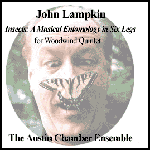|
Insects: A Musical Entomology in Six Legs

 Price: $6.95
Price: $6.95 |
For Checks and money orders
please E-mail
me.
|
Composers often look for fanciful themes and titles, and one of the most
successful is Saint Saens "Carnival of the Animals." I have created a
carnival myself, a musical entomology where each leg or movement is a musical
picture of a different insect. "Leafhoppers Dig Ragweed" pokes fun at the
traditional ways that rags are usually performed. You may hear that my rag
has more dissonance than Scott Joplin would have used. In a middle section,
each instrument in the quintet will try to outdo each other with leaps and
jumps.
The second leg is called "A moment in the Meadow" and sounds like an August
evening where three insects are chirping together and against each other,
drifting in and out of phase. You will hear that the oboe is one insect, the
clarinet, another, and the flute and bassoon together make the third. Since
the melodic fragments are short and simple, this leg is a minimalist work,
an intentional tip of the hat to the composers Phillip Glass and Steve Reich
who popularized the style.
The third leg is Mr. and Mrs. Flea, represented by the clarinet and the
piccolo, respectively, and as in any marriage, they often agree and disagree
in predictable fashion.
Composers and performers enjoy challenges, and the March of the Ants is
composed entirely of whole tone scales which have an unusual sound. Usually,
one instrument plays he melody while the others accompany. But here, each
instrument has to simultaneously play the melody and the accompaniment. All
except for the French horn is like the bugler in an old army, marshalling
the troops. So imagine perhaps that these are soldier ants off to do battle.
The distinctive feature of a firefly, is his glowing tail, and to convey this
image musically, I settled on trills. Up to this point in the suite, the
movements have used a lot of short phrases with staccato notes because to my
ear, that is the way that leafhoppers and fleas move. But fireflies float and
hover, so the phrases are long and flowing, and the poignant melody belongs
almost entirely to the flute, the most firefly-like instrument in the
ensemble.
The final leg is a cartoon, and treats the quintet as if it were a big band,
with a tip of the hat to Henry Mancini. You might imagine that Chubby is like
Mancini's Pink Panther, a loveable, jazzy and cool sort of guy, even though
he is a cockroach. If a firefly is a flute, then a cockroach must be a
bassoon. Sorry about that! Now there is no strict scenario that you should
envision for this cartoon, but as the movement progresses, you may in your
mind's eye see Chubby strut around, cautiously investigating his
surroundings. At one point, you he has a party in the pantry where he finds
bananas, or does he? Although Chubby is cool and hip, I'm afraid that nobody
likes a cockroach, so his life is in mortal danger throughout the movement.
I don't mean to alarm you animal lovers, and pacifists, but there may be
violence!!
-<Back to CD's>-
|



